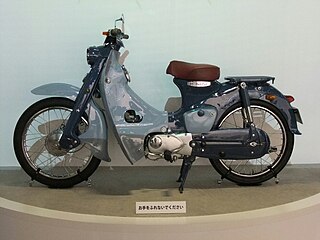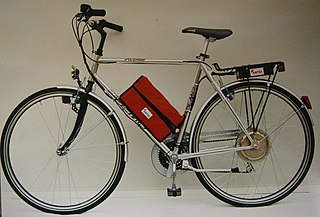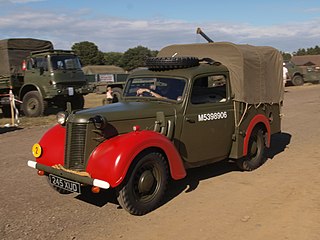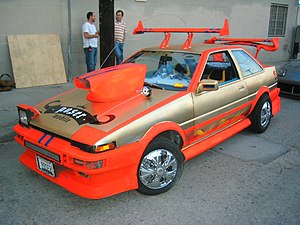
A straight-three engine is a three-cylinder piston engine where cylinders are arranged in a line along a common crankshaft.
Yamaha Motor Co., Ltd. is a Japanese mobility manufacturer that produces motorcycles, motorboats, outboard motors, and other motorized products. The company was established in the year 1955 upon separation from Nippon Gakki Co., Ltd. and is headquartered in Iwata, Shizuoka, Japan. The company conducts development, production and marketing operations through 109 consolidated subsidiaries as of 2012.

Suzuki Motor Corporation is a Japanese multinational mobility manufacturer headquartered in Hamamatsu, Shizuoka. It manufactures automobiles, motorcycles, all-terrain vehicles (ATVs), outboard marine engines, wheelchairs and a variety of other small internal combustion engines. In 2016, Suzuki was the eleventh biggest automaker by production worldwide. Suzuki has over 45,000 employees and has 35 production facilities in 23 countries, and 133 distributors in 192 countries. The worldwide sales volume of automobiles is the world's tenth largest, while domestic sales volume is the third largest in the country.

The Suzuki GSX1300R Hayabusa is a sports motorcycle made by Suzuki since 1999. It immediately won acclaim as the world's fastest production motorcycle, with a top speed of 303 to 312 km/h.

Stanley Michael Bailey Hailwood, was an English professional motorcycle racer and racing driver. He is regarded by many as one of the greatest racers of all time. He competed in the Grand Prix motorcycle world championships from 1958 to 1967 and in Formula One between 1963 and 1974. Hailwood was known as "Mike The Bike" because of his natural riding ability on motorcycles with a range of engine capacities.
Satra Corporation was a US trading and metal processing company. It is primarily known in the United Kingdom for its Satra Motors Limited subsidiary, which was the official importer and distributor of Soviet Union cars and motorcycles in that country from 1973 to 1979. Satra is an acronym for "Soviet American Trade Association".

Motobécane was a French manufacturer of bicycles, mopeds, motorcycles, and other small vehicles, established in 1923. "Motobécane" is a compound of "moto", short for motorcycle; "bécane" is slang for "bike."

The term "Universal Japanese Motorcycle", or UJM, was coined in the mid-1970s by Cycle Magazine to describe a proliferation of similar Japanese standard motorcycles that became commonplace following Honda's 1969 introduction of its successful CB750. The CB750 became a rough template for subsequent designs from all three of the other major Japanese motorcycle manufacturers. In 2011, the New York Times said lightning struck for Honda "with the 1969 CB 750, whose use of an inline 4-cylinder engine came to define the Universal Japanese Motorcycle."

A streetfighter, muscle bike, or supernaked is a type of high-performance motorcycle. It is typically a large-displacement sport bike with the fairings and windscreen removed. Beyond simply removing fairings, specific changes that exemplify the streetfighter look are a pair of large, round headlights, tall, upright handlebars such as those on a motocross bike, and short, loud, lightweight mufflers, and changes in the sprockets to increase torque and acceleration at lower speeds. Streetfighters is also the name of a UK motorcycle magazine.

The Honda Super Cub is a Honda underbone motorcycle with a four-stroke single-cylinder engine ranging in displacement from 49 to 124 cc.

An electric bicycle, e-bike, electrically assisted pedal cycles, or electrically power assisted cycles is a motorized bicycle with an integrated electric motor used to assist propulsion. Many kinds of e-bikes are available worldwide, but they generally fall into two broad categories: bikes that assist the rider's pedal-power and bikes that add a throttle, integrating moped-style functionality. Both retain the ability to be pedaled by the rider and are therefore not electric motorcycles. E-bikes use rechargeable batteries and typically are motor-powered up to 25 to 32 km/h. High-powered varieties can often travel more than 45 km/h (28 mph).

Fender is the American English term for the part of an automobile, motorcycle or other vehicle body that frames a wheel well. Its primary purpose is to prevent sand, mud, rocks, liquids, and other road spray from being thrown into the air by the rotating tire. Fenders are typically rigid and can be damaged by contact with the road surface.
The history of the motorcycle begins in the second half of the 19th century. Motorcycles are descended from the "safety bicycle," a bicycle with front and rear wheels of the same size and a pedal crank mechanism to drive the rear wheel. Despite some early landmarks in its development, the motorcycle lacks a rigid pedigree that can be traced back to a single idea or machine. Instead, the idea seems to have occurred to numerous engineers and inventors around Europe at around the same time.

Dyke is a slang term, used as a noun meaning lesbian. It originated as a homophobic slur for masculine, butch, or androgynous girls or women. Pejorative use of the word still exists, but the term dyke has been reappropriated by many lesbians to imply assertiveness and toughness.

Moto Martin is a French engineering company, started by Georges Martin, known for its motosport inspired or Café racer style racing frame kits for motorcycles. The original Moto Martin frame designs were based on the work of Fritz Egli. The company also manufactured its own wheels, body kits and, later, kitcars. Georges Martin capitalized upon building kit cars at a time when many riders in Europe couldn't afford to build their own modified cars. One model is known as a KZ900 Turbo. Cycle World in 1987 stated that "Moto Martin's products have a reputation for high-quality construction that places them above the level of most other frame manufacturers." Moto Martin motorcycles have been compared to the likes of Bimota, Harris and Nico Bakker.
This is a glossary of motorcycling terms.
Forced induction in motorcycles is the application of forced induction to a motorcycle engine. Special automotive engineering and human factors considerations exist for the application of forced induction with motorcycles, compared to other forms of motorized transportation.












